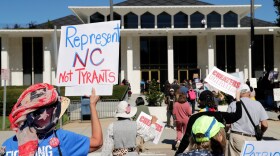As North Carolina lawmakers hash out voting districts, there’s a lot of discussion about how to fairly draw those lines. But left out of that talk is one particular population: about 40,000 inmates in state and federal prisons.
Twelve states have decided to count state prisoners in the area where they last resided with the aim of more fairly distributing power. North Carolina has no plans to do that on the state level, but some local jurisdictions are grappling with how to handle prisoners as they redistrict.
Five percent of Granville County residents are prisoners. It’s home to a state prison and the Butner Federal Correctional Complex.
“You’ve got every level of prison that you can think of, so those folks all went into the census count,” said G ranville County C ommiss ioner T im Karan.
Because of that , the county has decided to count the pri soner s as residents for purposes of drawing political lines. In G ranvill e 's last redistricting in 2013, that left one county commission and school board district with inmates comprising nearly a third of residents. That was a smaller share than what it had been.
This time around, Karan said the county needs to draw those lines as if the prisons weren’t there.
“We should absolutely exclude them because it’s beneficial to me to have a smaller number of individuals that I serve and it’s crucial for them to have not somebody in the county that supposedly has extra representation,” said Karan.
However, it’s not a topic Karan hears much about from his constituents and he doesn’t think it actually impacts how commission ers' decisions play out.
Hillary Harris Klein, an attorney with the Southern Coalition for Social Justice based in Durham, said counting prisoners this way distorts representation most at the local level, but it has ripple effects throughout states.
“If you think about the fact that people are often incarcerated in rural areas, there’s a power shift happening from urban areas to rural areas of representation where people are being counted for the census in one area, but their genuine constituent relationship is back home and that’s often in urban areas,” said Harris Klein.
That often means rural areas see their population numbers inflated by prison populations that are disproportionately Black and Latino, which comprise 43 % of North Carolina’s state prison population. In North Carolina, that racial difference may not be so great, since several of the counties where prisons are located already have a sizable Black population.
Still, prisoners comprise a large share of residents in many of the state’s counties, according to the Marshall Project. In Greene County in the eastern part of the state, it’s 15 % . In coastal Hyde County, it’s 12 % and in Anson County closer to C harlo tte, it’s 6 % .
“The best solution to this would be for the census to count people who are incarcerated at their last residence before they were incarcerated,” said Harris Klein. “That would be, we think, the most accurate way of accounting for those people.”
A recent study about Pennsylvania’s state legislative districts by Villanova University professors found “a substantial likelihood” that Philadelphia would gain an additional majority-minority district if the state reallocated prisoner counts. Pennsylvania is now among 12 states that plan to count prisoners this way.
In North Carolina, the idea hasn’t gained any political traction, said Democratic s tate Sen . Natasha Marcus of Mecklenburg County. She’s on the North C arolina Senate’s redistricting committee.
“It’s not the way we’ve done it before , and I haven’t heard anyone bring it up as an option for North Carolina,” said Marcus.
A spokes pe rson for Republica n state Senate leader Phil Berger sa id legislators don’t see a good rationale to apply one residence rule to nearly all of the population and a different r ule to a small subset.
Bob Phillips, the head of Common Cause, one of the state’s major voting rights group s, says racial and partisan gerrymandering has kept the organization so busy that the prison issue has gotten somewhat lost in the shuffle.
“It is one of those issues in this very complicated and convoluted topic of redistricting that really does need to be addressed,” said Phillips. “We are definitely interested in it, but we haven’t probably focused as much attention on it as maybe we should have and maybe as it deserves.”
For now , the Southern Coalition for Social Justice is focusing its efforts on getting local jurisdictions to draw voting districts without counting prisoners as residents. They’ve sent letters to 16 North Carolina counties, cities and school boards where inmates make up significant portions of districts explaining how they can do it.
The Prison Policy Initiative, a group also advocating for the change, tracks districts like these. The group’s legal director , Aleks Kajstura , said North Carolina isn’t the worst state she’s seen in this regard, but it has a long way to go.
“We're looking at places in North Carolina where 40 % or so of a city or county district . .. is folks that are incarcerated and that is sadly not the worst in the country,” said Kajstura.
She says more than 200 local jurisdictions, including Columbus and Caswell counties in N orth Ca rolina, excluded prisoners from their population counts in the last redistricting cycle.
That’s what Granville C ounty commissioners are now thinking they’ll do , too, says Karan. Many other prison communities in the next few weeks will have to figure out whether they’ll count prisoners as constituents.
Copyright 2021 WFAE. To see more, visit WFAE. 9(MDAxNzg0MDExMDEyMTYyMjc1MDE3NGVmMw004))






